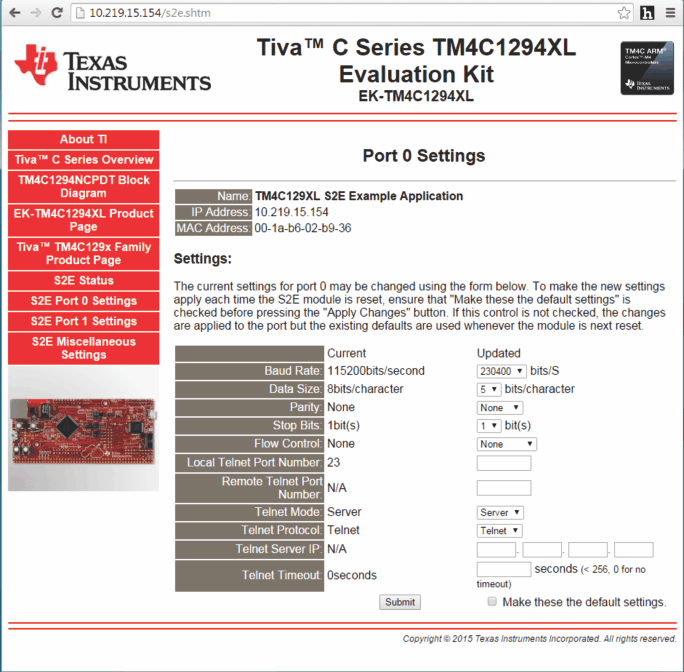SPMA072 March 2015 TM4C1294KCPDT , TM4C1294KCPDT , TM4C1294NCPDT , TM4C1294NCPDT , TM4C1294NCZAD , TM4C1294NCZAD , TM4C1299KCZAD , TM4C1299KCZAD , TM4C1299NCZAD , TM4C1299NCZAD , TM4C129EKCPDT , TM4C129EKCPDT , TM4C129ENCPDT , TM4C129ENCPDT , TM4C129ENCZAD , TM4C129ENCZAD , TM4C129XKCZAD , TM4C129XKCZAD , TM4C129XNCZAD , TM4C129XNCZAD
5.2.2 S2E Port 0 and Port 1 Settings Page
The “Port 0 Settings” page allows configuration of port 0 of the S2E module. Similarly, the “Port 1 Settings” page allows configuration of port 1 of the S2E module. The following configuration options are provided:
- Baud Rate – specifies the baud rate to be used by the serial port. There are several options up to 230400 bits/S.
- Data Size – configures the number of data bits per character. The options are 5 to 8 bits per character.
- Parity – specifies the generation and checking of the parity bit in the data frame and the type of parity used. The options are “None”, “Odd”, “Even”, “Mark”, and “Space”.
- Stop Bits – specifies the number of stop bits at the end of a frame. The options are 1 and 2 bits per character.
- Flow Control – specifies the use of flow control. The options are “None” and “Hardware”.
- Local Telnet Port Number – specifies the local telnet port number to be used.
- Remote Telnet Port Number – specifies the remote telnet port number to be used when the “Telnet Mode” is set to “Client”.
- Telnet Mode – specifies whether the telnet mode for that port will be “Server” or “Client”.
- Telnet Protocol – specifies whether the data for the port will be “Telnet” or “Raw”.
- Telnet Server IP – specifies the IP address of the telnet server when the “Telnet Mode” is set to “Client”.
- Telnet Timeout – specifies the telnet timeout in seconds. The default is 0 and specifies that no timeout is to be used.
After changing the settings, click the “Submit” button. If the “Make these the default settings” check box is checked before clicking the “Submit” button, then the new settings are applied each time the S2E module is reset. Otherwise, the existing defaults are used whenever the module is next reset. Figure 5 shows the Port 0 Settings page.
 Figure 5. S2E Port 0 Settings Page
Figure 5. S2E Port 0 Settings Page